All literature is the search for a better metaphor
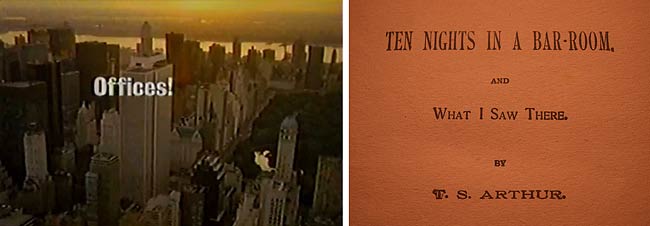
The basic concept is that we think writers should be paid for their work.
{ Why the Times Pays Writers Even When It Doesn’t Have To | Forbes | full story }

The basic concept is that we think writers should be paid for their work.
{ Why the Times Pays Writers Even When It Doesn’t Have To | Forbes | full story }
Tech bubbles happen, but we usually gain from the innovation left behind. This one—driven by social networking—could leave us empty-handed
As a 23-year-old math genius one year out of Harvard, Jeff Hammerbacher arrived at Facebook when the company was still in its infancy. This was in April 2006, and Mark Zuckerberg gave Hammerbacher—one of Facebook’s first 100 employees—the lofty title of research scientist and put him to work analyzing how people used the social networking service. Specifically, he was given the assignment of uncovering why Facebook took off at some universities and flopped at others. The company also wanted to track differences in behavior between high-school-age kids and older, drunker college students. “I was there to answer these high-level questions, and they really didn’t have any tools to do that yet,” he says.
Over the next two years, Hammerbacher assembled a team to build a new class of analytical technology. His crew gathered huge volumes of data, pored over it, and learned much about people’s relationships, tendencies, and desires. Facebook has since turned these insights into precision advertising, the foundation of its business. (…)
After a couple years at Facebook, Hammerbacher grew restless. He figured that much of the groundbreaking computer science had been done. Something else gnawed at him. Hammerbacher looked around Silicon Valley at companies like his own, Google, and Twitter, and saw his peers wasting their talents. “The best minds of my generation are thinking about how to make people click ads,” he says. “That sucks.” (…)
Hammerbacher quit Facebook in 2008, took some time off, and then co-founded Cloudera, a data-analysis software startup. He’s 28 now and speaks with the classic Silicon Valley blend of preternatural self-assurance and save-the-worldism. (…) He’s not really a programmer or an engineer; he’s mostly just really, really good at math. (…)
On Wall Street, the math geeks are known as quants. They’re the ones who create sophisticated trading algorithms that can ingest vast amounts of market data and then form buy and sell decisions in milliseconds. Hammerbacher was a quant. After about 10 months, he got back in touch with Zuckerberg, who offered him the Facebook job in California. That’s when Hammerbacher redirected his quant proclivities toward consumer technology.

Remember Paul Ceglia? He’s the fellow in upstate New York who sued Mark Zuckerberg last July, claiming that, way back in 2003, Zuckerberg had agreed to give him a 50% ownership in the project that became Facebook.
That claim seemed preposterous at the time, not least because Ceglia had waited 7 years to file it. And there was also the fact that Ceglia was a convicted felon, having been charged with criminal fraud in connection with a wood-pellet company he operated. (…)
But now Paul Ceglia has refiled his lawsuit. With a much larger law firm. And a lot more evidence. And the new evidence is startling.

For decades Richard Beckman was among those responsible for turning magazines such as Vanity Fair, GQ, and Vogue into cash machines for Condé Nast, which publishes those titles and a long list of others. (…)
With Prometheus, Beckman is trying to repeat his success within the least glamorous sector of publishing—trade magazines—at a time when print has practically been given up for dead in some quarters. Not only is $70 million of other people’s money at stake; so, it seems, is Beckman’s reputation and the sense that he can be a successful visionary on his own.
After Prometheus bought The Hollywood Reporter, paid circulation of the daily was reported by BPA Worldwide to be just over 12,000. Since relaunching it as a weekly, Beckman says circulation is 72,000, but he refuses to disclose the breakdown of paid vs. free subscriptions. These 72,000 people—the influencers—are pretty much the best 72,000 people any advertiser could dream of reaching, he says. While most of Beckman’s energy has been focused on The Hollywood Reporter thus far, he hopes to apply his approach to Prometheus’s other publications as well. (…)
The New York Post has just printed a story declaring that investors in Beckman’s one-year-old company, Prometheus Global Media, which owns The Hollywood Reporter, Adweek, Billboard, and other trade magazines, are scrambling to get out of their investment. For a man trying to reinvent an Old Media business, the last thing you want to read is that when your company forked over $70 million for eight publications in 2009, it “overpaid.”
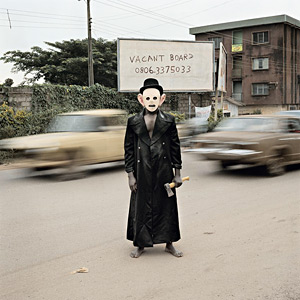
A new exciting paper in the forthcoming Journal of Consumer Psychology makes the case that money should buy us happiness, but most people aren’t spending it right. On the edge of psychology and economics, Profs. Daniel Gilbert, Elizabeth Dunn and Timothy Wilson lay out eight principles of spending efficiently, including:
1) Buy more experiences and fewer objects.
2) Don’t worry about insurance.
3) The frequency of happy events matters more than their intensity.
photo { Pieter Hugo }

I was in the middle of teaching the difference between knowledge and belief when my cell phone buzzed in my pocket. It was a call from the dean of the University of Nevada, Las Vegas College of Liberal Arts.
The dean informed me that he was very sorry but, barring an unlikely immediate solution to the state’s financial crisis, the university had decided to eliminate the Philosophy Department, which I chair.
In July, I would be given a one-year terminal contract. After that, the university would fire me, along with all of my departmental colleagues, after twenty years of service.

In a closely-watched oral argument Monday at a federal courthouse in Washington, the core questions of the case read like scripts from a college philosophy exam: are isolated human genes and the subsequent comparisons of their sequences patentable? Can one company own a monopoly on such genes without violating the rights of others? They are multi-billion dollar questions, the judicially-sanctioned answers to which will have enormous ramifications for the worlds of medicine, science, law, business, politics and religion.
Even the name of the case at the U.S. Circuit Court for the Federal Circuit — Association of Molecular Pathology, et al. v United States Patent and Trademark Office, et al — oozes significance. The appeals court judges have been asked to determine whether seven existing patents covering two genes — BRCA1 and BRCA2 (a/k/a “Breast Cancer Susceptibility Genes 1 and 2″) — are valid under federal law or, instead, fall under statutory exceptions that preclude from patentability what the law identifies as ”products of nature.”
In other words, no one can patent a human being. Not yet anyway.
painting { Jenny Saville, Plan, 1993 }

As of 2009 there were 3,020 museums in China, including 328 private museums (the American Association of Museums estimates 17,500 in the US). One hundred new museums are being added each year. In March the government made entry to museums of modern and contemporary art free. The torrid pace of museum development is part of a national drive to build cultural infrastructure and, as Cai Wu, the minister of culture, put it earlier this year in a published comment, “to establish a batch of world-famous cultural brands.”
“The next ten years should be a golden period for the development of every aspect of cultural industries in China,” said Ye Lang. “The country isn’t just satisfied with the economic achievements it had made,” the Xinhua news agency announced in January. “What it now needs is all-round cultural influence on an international scale.” The government backs these ambitions with a cultural outlay of $4.45bn in 2009, excluding construction costs.
photo { Mike Osborne }
Alvin Roth spent years writing academic papers about the medical job market — specifically, picking apart the national system that matched young doctors to their first hospital jobs out of medical school. (…)
When it was introduced in the 1950s, the National Resident Matching Program was supposed to help doctors with the stressful and chaotic problem of finding their hospital internships. But after four decades, it was showing its age. Some medical students complained that the process was unfair, and that hospitals were being given too much power in determining where new doctors would live and work. Above all, the system was faltering because it was designed at a time when virtually no women became doctors, which meant it couldn’t handle married couples applying simultaneously. The result was that young doctors were passing up job opportunities for family reasons, and in some cases husbands and wives were assigned to distant cities and asked to choose their careers over each other.
As a professor who specialized in game theory, Roth had been studying medical matching programs closely since the early 1980s, figuring out what worked and what didn’t, and what rules were required to make a system in which everyone — the hospitals, the doctors — ended up happiest. He had coauthored a book full of theories and equations related to the problem of matching in general. He was so well known for this, one colleague remembers, that medical students would call him every year for advice on how to game the system. (…)
Roth has emerged as a rare figure in the academic world: a theorist willing to dive into real-world problems and fix them. After helping the med students, he designed a better way to assign children to public schools — the system now used by both Boston and New York. He also helped invent a system for matching kidney donors with patients, dramatically increasing the number of donations that take place each year.
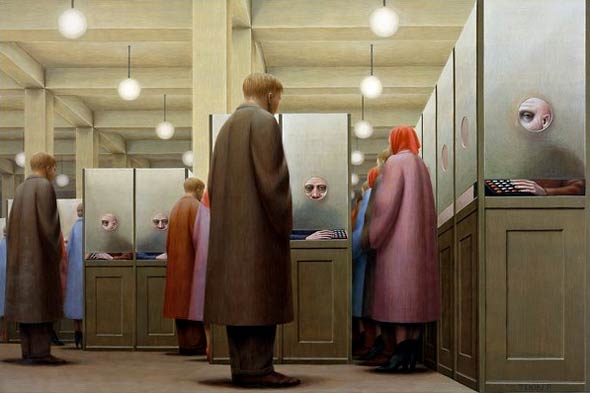
Research by McGill Sociology Professor Eran Shor, working in collaboration with researchers from Stony Brook University, has revealed that unemployment increases the risk of premature mortality by 63 per cent. Shor reached these conclusions by surveying existing research covering 20 million people in 15 (mainly western) countries, over the last 40 years.
One surprising finding was that (…) the correlation between unemployment and a higher risk of death was the same in all the countries covered by the study. (…)
The research also showed that unemployment increases men’s mortality risk more than it does women’s mortality risk (78 per cent vs. 37 per cent respectively).
painting { George Tooker, Painter Capturing Modern Anxieties, Dies at 90 }

{ $1,700: The annual benefit the average American derives from personal computers. | WSJ | full story }

The upper 1 percent of Americans are now taking in nearly a quarter of the nation’s income every year. In terms of wealth rather than income, the top 1 percent control 40 percent. Their lot in life has improved considerably. Twenty-five years ago, the corresponding figures were 12 percent and 33 percent. One response might be to celebrate the ingenuity and drive that brought good fortune to these people, and to contend that a rising tide lifts all boats. That response would be misguided. While the top 1 percent have seen their incomes rise 18 percent over the past decade, those in the middle have actually seen their incomes fall. For men with only high-school degrees, the decline has been precipitous—12 percent in the last quarter-century alone. All the growth in recent decades—and more—has gone to those at the top. In terms of income equality, America lags behind any country in the old, ossified Europe that President George W. Bush used to deride. Among our closest counterparts are Russia with its oligarchs and Iran.
photo { Keith Arnatt }

The annals of business history are full of tales of companies that once dominated their industries but fell into decline. The usual reasons offered don’t fully explain how the leaders who had steered these firms to greatness lost their touch.
In this article we argue that success can breed failure by hindering learning at both the individual and the organizational level. We all know that learning from failure is one of the most important capacities for people and companies to develop. Yet surprisingly, learning from success can present even greater challenges.

{ The cellphone has been more than a cellphone for years, but soon it could take on an entirely new role — standing in for all of the credit and debit cards crammed into wallets. There’s just one hitch: While the technology is already being installed in millions of phones — and is used overseas — wide adoption of the so-called mobile wallets is being slowed by a major behind-the-scenes battle among corporate giants. | NY Times | Continue reading }
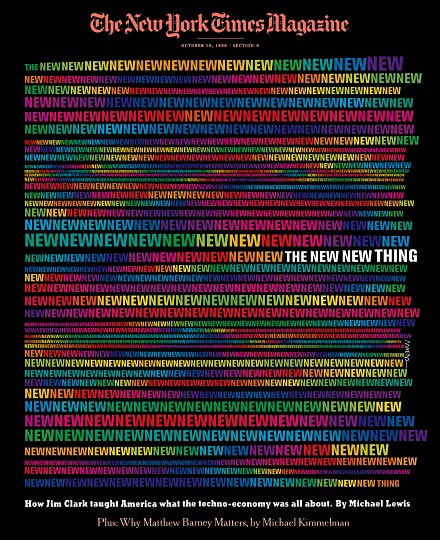
{ The New York Times paywall is costing the newspaper $40-$50 million to design and construct, Bloomberg has reported. And it can be defeated through four lines of Javascript. | Nieman Journalism Lab | full story | image: New York Times Magazine cover by John Maeda }
related:
A federal judge rejected Google’s $125 million class-action settlement with authors and publishers, delivering a blow to the company’s ambitious plan to build the world’s largest digital library and bookstore. (…)
The court’s decision throws into legal limbo one of Google’s most ambitious projects: a plan to digitize millions of books from libraries.
The Authors Guild and the Association of American Publishers sued Google in 2005 over its digitizing plans. After two years of painstaking negotiations, the authors and publishers devised with Google a sweeping settlement that would have helped to bring much of the publishing industry into the digital age.
The deal turned Google, the authors and the publishers into allies who defended the deal against an increasingly vocal chorus of opponents that included academics, copyright experts, the Justice Department and foreign governments. (…)
The deal would have allowed Google to make millions of out-of-print books broadly available online and to sell access to them, while giving authors and publishers new ways to earn money from digital copies of their works. Yet the deal faced a tidal wave of opposition from Google rivals like Amazon and Microsoft, as well as some academics, authors, legal scholars, states and foreign governments. The Justice Department opposed the deal, fearing that it would give Google a monopoly over millions of so-called orphan works, books whose right holders are unknown or cannot be found.
AT&T is paying $1300 per T-Mobile subscriber and by the time the deal is finished extra costs will probably raise that to $1400 or more.
Were I [Verizon CEO] Seidenberg, then, I’d spend right up to that level to snag customers from T-Mobile. Anything under $1300 is a bargain.
{ Robert X. Cringely | Continue reading | AT&T needs T-Mobile most for its WiFi }

Even if Japan’s nuclear crisis is contained, its earthquake and tsunami now seem certain to be, economically speaking, among the worst natural disasters in history, with total losses potentially as high as two hundred billion dollars. In response, fearful investors sent the Nikkei down almost twenty per cent on the first day of trading after the tsunami, and it’s still down more than ten per cent. Yet, while the fear is understandable, this may turn out to have been an overreaction: history suggests that, despite the terrifying destruction and the horrific human toll, the long-term impact of the quake on the Japanese economy could be surprisingly small.
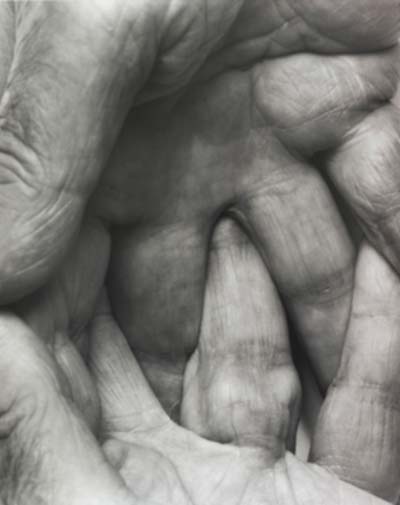
The Federal Reserve has blessed the balance sheet of Goldman Sachs — paving the way for the investment bank to pay back the $5 billion investment that Warren Buffett made at the height of the financial crisis in 2008. (…)
In the darkest days of the financial crisis, Mr. Buffett agreed to invest $5 billion in Goldman Sachs, whose stock was suffering amid a general liquidity scare. The deal in September 2008 came at a hefty price, namely a 10 percent annual dividend that amounted to about $500 million.
At the time, Mr. Buffett also picked up warrants, giving Berkshire the right to buy $5 billion of stock with a strike price of $115. With Goldman stock currently trading at $160, Buffett’s profit on the warrants is around $2 billion.
{ NY Times | Continue reading }
For the first time, researchers prompted the very rich—people with fortunes in excess of $25 million—to speak candidly about their lives. The result is a suprising litany of anxieties: their sense of isolation, their worries about work and love, and most of all, their fears for their children.
photo { John Coplans }
The Prime Minister of Japan recently stated that his nation was facing its worst crisis since World War II. While most of the world is focused on tragic images of floodwater and rubble, and fixated on radiation levels, there is a bigger picture to be examined – one that also includes energy, coal and the Strait of Hormuz.
The geography of the Persian Gulf is extraordinary. It is a narrow body of water opening into a narrow channel through the Strait of Hormuz. Any diminution of the flow from any source in the region, let alone the complete closure of the Strait of Hormuz, would have profound implications for the global economy.
For Japan it could mean more than higher prices. It could mean being unable to secure the amount of oil needed at any price. The movement of tankers, the limits on port facilities and long-term contracts that commit oil to other places could make it impossible for Japan to physically secure the oil it needs to run its industrial plant. On an extended basis, this would draw down reserves and constrain Japan’s economy dramatically. And, obviously, when the world’s third-largest industrial plant drastically slows, the impact on the global supply chain is both dramatic and complex.
{ George Friedman | Continue reading }
Nuclear plants in France, Germany, and the U.S. are far more automated than in Japan, where more controls are based on manual decisions, switches, and reactions, says Roger Gale, a nuclear industry consultant and former official at the U.S. Department of Energy who served as a consultant to Tepco for 20 years. He thinks U.S. utilities would have acted more quickly in a similar disaster. “[Tepco] probably reacted more slowly in the initial case than they needed to.”
Gale says a culture of complacency within Tepco may also have contributed to the crisis. Tepco has massive cash flows and a reputation for hiring the best and brightest engineers in Japan. However, Gale says, an array of management problems–a lack of transparency, problems with record keeping, relying on manual rather than automatic controls, and being slow on the draw when making decisions—plague the organization.
{ Fast Company | Continue reading }
At this point in the Japanese nuclear emergency it is coming down to the simple proposition of how do you drop enough water on the stricken reactors, and especially the spent fuel ponds, to keep further damage from happening?
{ Robert X. Cringely | Continue reading | And: Japan Takes Extraordinary Measures to Cool Nuclear Plant }
related { CNN/Money jumps on the fear bandwagon with this interactive graphic }